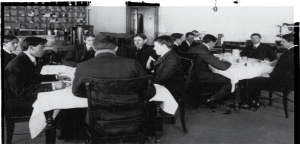
Members of the Poison Squad dine at the ‘hygienic table’ located in the former Bureau of Chemistry building in Washington, D.C. Experiments conducted there a century ago by Harvey W. Wiley. MD. were designed to test the safety of food preservatives.
America owes its food safety success to 12 young men who, beginning in 1902, ate poisoned meals from a government-run kitchen to test new food preservatives, according to a new Atlas Obscura article.
The men, part of what was called the Poison Squad co-ordinated by chief chemist Harvey Wiley, sat down in pressed suits and bow ties for five years to eat delicious meals laced with formaldehyde, benzoate and borax. Mostly employees of the Bureau of Chemistry or Georgetown Medical College students, the men leapt at the chance of extra money, free room and board.
Using a $5000 government grant, Wiley bought food, hired a cook and recruited the men (women were not allowed to join). Each participant was carefully observed before and after meals, and as they ate meats and consumed drinks laced with increasing amounts of suspected poisons, the public fell in love with them. To this day, however, most of their names are unknown.
Those consuming borax went on strike in May 1903 because of severe stomach aches, loss of appetite and headaches. By the end of the Poison Squad’s existence in 1907, those who didn’t withdraw from the experiment were observed to be “on a slow approach toward death.” Formaldehyde, which was often used in dairy products, strained the kidneys and made the test subjects sick. Benzoate caused unhealthy weight loss and blood vessel damage.
When one squad member died of tuberculosis (allegedly after being weakened from poison), his family threatened to sue. Finally, after five years of testing dangerous ingredients, Wiley decided he had gathered enough evidence that these common food additives were hurting people.




























































































